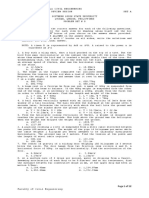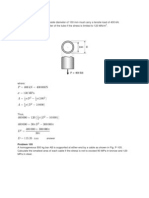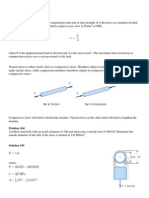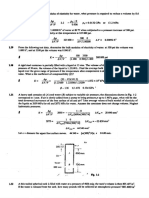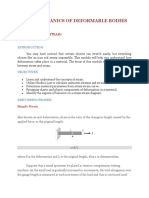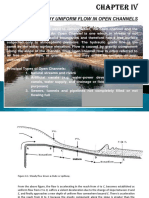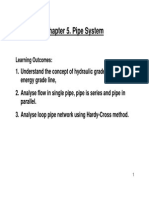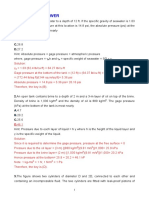Problem 115
Uploaded by
Ian Jimbo ConstantinoProblem 115
Uploaded by
Ian Jimbo ConstantinoPROBLEM 115, PAGE 16 What force is required to punch a 20-mm-diameter hole in a plate that is 25 mm thick?
The shear strength is 350 MN/m. Given: Required diameter of hole = 20 mm Thickness of plate = 25 mm Shear strength of plate = 350 MN/m2 Required: Force required to punch a 20-mm-diameter hole Solution 115
The resisting area is the shaded area along the perimeter and the shear force is equal to the punching force .
answer
PROBLEM 116, PAGE 17 As in Fig. 1-11c, a hole is to be punched out of a plate having a shearing strength of 40 ksi. The compressive stress in the punch is limited to 50 ksi. (a) Compute the maximum thickness of plate from which a hole 2.5 in. in diameter can be punched. (b) If the plate is 0.25 in. thick, determine the diameter of the smallest hole that can be punched.
Given: Shear strength of plate = 40 ksi Allowable compressive stress of punch = 50 ksi Required: a. Maximum thickness of plate to punch a 2.5 inches diameter hole b. Diameter of smallest hole if the plate is 0.25 inch thick Solution 116 a. Maximum thickness of plate: Based on puncher strength: Equivalent shear force of the plate Based on shear strength of plate: answer b. Diameter of smallest hole: Based on compression of puncher: Equivalent shear force for plate Based on shearing of plate: answer Problem 117
Find the smallest diameter bolt that can be used in the clevis shown in Fig. 111b if P = 400 kN. The shearing strength of the bolt is 300 MPa.
Given: Force P = 400 kN Shear strength of the bolt = 300 MPa Required: Diameter of the smallest bolt Solution 117 The bolt is subject to double shear. answer
Problem 118 A 200-mm-diameter pulley is prevented from rotating relative to 60-mmdiameter shaft by a 70-mm-long key, as shown in Fig. P-118. If a torque T = 2.2 kNm is applied to the shaft, determine the width b if the allowable shearing stress in the key is 60 MPa.
Problem 119 Compute the shearing stress in the pin at B for the member supported as shown in Fig. P-119. The pin diameter is 20 mm. Problem 120 The members of the structure in Fig. P-120 weigh 200 lb/ft. Determine the smallest diameter pin that can be used at A if the shearing stress is limited to 5000 psi. Assume single shear.
Problem 121 Referring to Fig. P-121, compute the maximum force P that can be applied by the machine operator, if the shearing stress in the pin at B and the axial stress in the control rod at C are limited to 4000 psi and 5000 psi, respectively. The diameters are 0.25 inch for the pin, and 0.5 inch for the control rod. Assume single shear for the pin at B. Problem 122 Two blocks of wood, width w and thickness t, are glued together along the joint inclinedat the angle as shown in Fig. P-122. Using the free-body diagram concept in Fig. 1-4a,show that the shearing stress on the glued joint is = P sin 2/2A, where A is the cross-sectional area. Problem 123 A rectangular piece of wood, 50 mm by 100 mm in cross section, is used as a compression block shown in Fig. P-123. Determine the axial force P that can be safely applied to the block if the compressive stress in wood is limited to 20 MN/m2 and the shearing stress parallel to the grain is limited to 5 MN/m2. The grain makes an angle of 20 with the horizontal, as shown. (Hint: Use the results in Problem 122.)
You might also like
- Strength of Materials 4th Edition by Pytel and Singer82% (11)Strength of Materials 4th Edition by Pytel and Singer5 pages
- Helical Springs and Shear and Moment DiagramNo ratings yetHelical Springs and Shear and Moment Diagram25 pages
- EXAM in DYNAMICS For TIP-QC FR Sir RegidorNo ratings yetEXAM in DYNAMICS For TIP-QC FR Sir Regidor2 pages
- ' K AV/v': Ks 2377 2 - 2 P, 0.013201 A orNo ratings yet' K AV/v': Ks 2377 2 - 2 P, 0.013201 A or1 page
- Philippine Agricultural and Engineering Standards (Paes)No ratings yetPhilippine Agricultural and Engineering Standards (Paes)3 pages
- D'alembert's Principle and Centrifugal ForceNo ratings yetD'alembert's Principle and Centrifugal Force4 pages
- Hideclick Here To Show or Hide The Solution: AnswerNo ratings yetHideclick Here To Show or Hide The Solution: Answer28 pages
- Garcia, Jonalie M. ACTIVITY ON PYRAMIDS (PART 10)No ratings yetGarcia, Jonalie M. ACTIVITY ON PYRAMIDS (PART 10)4 pages
- Multiple Choice Questions in Engineering Mathematics by Diego Inocencio T. Gillesania100% (4)Multiple Choice Questions in Engineering Mathematics by Diego Inocencio T. Gillesania145 pages
- Mechanics of Deformable Bodies Module 2No ratings yetMechanics of Deformable Bodies Module 219 pages
- The Outside Diameter of The Tube If The Stress Is Limited To 120 MN/MNo ratings yetThe Outside Diameter of The Tube If The Stress Is Limited To 120 MN/M19 pages
- Chapter IV - Open Channel Uniform Flow-1No ratings yetChapter IV - Open Channel Uniform Flow-184 pages
- HYBP 324 PART IVB. Flow in Open Channel Autosaved 2-1No ratings yetHYBP 324 PART IVB. Flow in Open Channel Autosaved 2-129 pages
- Radium Decomposes at A Rate Proportional To The Quantity of Radium PresentNo ratings yetRadium Decomposes at A Rate Proportional To The Quantity of Radium Present3 pages
- This Study Resource Was: Si Units Thermodynamics 6 EditionNo ratings yetThis Study Resource Was: Si Units Thermodynamics 6 Edition9 pages
- Lecture 1 Kinematics of Particle Rectilinear TranslationNo ratings yetLecture 1 Kinematics of Particle Rectilinear Translation33 pages
- Module 2 - ABE Common Materials - No PretestNo ratings yetModule 2 - ABE Common Materials - No Pretest13 pages
- Non-Renewable Fuels Environmental Impact: EGEE 102 - Energy Conservation and Environmental ProtectionNo ratings yetNon-Renewable Fuels Environmental Impact: EGEE 102 - Energy Conservation and Environmental Protection40 pages
- Jntuh BT Che 5 Mass-Transfer-Operations-I-2011No ratings yetJntuh BT Che 5 Mass-Transfer-Operations-I-20118 pages
- Shells With Thickness Stretch in LS-DYNA: N S e S V V N S X XNo ratings yetShells With Thickness Stretch in LS-DYNA: N S e S V V N S X X3 pages
- Convection Diffusion and Reaction InsideNo ratings yetConvection Diffusion and Reaction Inside11 pages
- Glucide 55% Lipide 17% Protein 28%: Dieta 1757 Kcal % Din Total Calorii Glucide 55% Lipide 17% Proteine 28%No ratings yetGlucide 55% Lipide 17% Protein 28%: Dieta 1757 Kcal % Din Total Calorii Glucide 55% Lipide 17% Proteine 28%3 pages
- Analyzing The Effect and Efficiency of Wind Tower On Fresh Air Handling Unit (FAHU) For Medical BuildingsNo ratings yetAnalyzing The Effect and Efficiency of Wind Tower On Fresh Air Handling Unit (FAHU) For Medical Buildings7 pages
- CIVT 3201K Civil Engineering Materials New2No ratings yetCIVT 3201K Civil Engineering Materials New25 pages
- Essential Checking of Finite Element AnalysisNo ratings yetEssential Checking of Finite Element Analysis13 pages
- Deformation-Based Support Selection For Tunnels in Strainburst-Prone Ground-KaiserNo ratings yetDeformation-Based Support Selection For Tunnels in Strainburst-Prone Ground-Kaiser14 pages
- Be Civil 3rd Semester Syllabus1492571380 PDFNo ratings yetBe Civil 3rd Semester Syllabus1492571380 PDF17 pages
- COOLPLUS-Glc - GLL Oil Cooler Heat ExchangerNo ratings yetCOOLPLUS-Glc - GLL Oil Cooler Heat Exchanger4 pages
- Thermos Flask: Name-Itina Upasana +3 2nd Yr Phy Hons. ROLL NO - 2002010790580016No ratings yetThermos Flask: Name-Itina Upasana +3 2nd Yr Phy Hons. ROLL NO - 200201079058001615 pages
- Strength of Materials 4th Edition by Pytel and SingerStrength of Materials 4th Edition by Pytel and Singer
- Philippine Agricultural and Engineering Standards (Paes)Philippine Agricultural and Engineering Standards (Paes)
- Hideclick Here To Show or Hide The Solution: AnswerHideclick Here To Show or Hide The Solution: Answer
- Multiple Choice Questions in Engineering Mathematics by Diego Inocencio T. GillesaniaMultiple Choice Questions in Engineering Mathematics by Diego Inocencio T. Gillesania
- The Outside Diameter of The Tube If The Stress Is Limited To 120 MN/MThe Outside Diameter of The Tube If The Stress Is Limited To 120 MN/M
- HYBP 324 PART IVB. Flow in Open Channel Autosaved 2-1HYBP 324 PART IVB. Flow in Open Channel Autosaved 2-1
- Radium Decomposes at A Rate Proportional To The Quantity of Radium PresentRadium Decomposes at A Rate Proportional To The Quantity of Radium Present
- This Study Resource Was: Si Units Thermodynamics 6 EditionThis Study Resource Was: Si Units Thermodynamics 6 Edition
- Lecture 1 Kinematics of Particle Rectilinear TranslationLecture 1 Kinematics of Particle Rectilinear Translation
- Non-Renewable Fuels Environmental Impact: EGEE 102 - Energy Conservation and Environmental ProtectionNon-Renewable Fuels Environmental Impact: EGEE 102 - Energy Conservation and Environmental Protection
- Shells With Thickness Stretch in LS-DYNA: N S e S V V N S X XShells With Thickness Stretch in LS-DYNA: N S e S V V N S X X
- Glucide 55% Lipide 17% Protein 28%: Dieta 1757 Kcal % Din Total Calorii Glucide 55% Lipide 17% Proteine 28%Glucide 55% Lipide 17% Protein 28%: Dieta 1757 Kcal % Din Total Calorii Glucide 55% Lipide 17% Proteine 28%
- Analyzing The Effect and Efficiency of Wind Tower On Fresh Air Handling Unit (FAHU) For Medical BuildingsAnalyzing The Effect and Efficiency of Wind Tower On Fresh Air Handling Unit (FAHU) For Medical Buildings
- Deformation-Based Support Selection For Tunnels in Strainburst-Prone Ground-KaiserDeformation-Based Support Selection For Tunnels in Strainburst-Prone Ground-Kaiser
- Thermos Flask: Name-Itina Upasana +3 2nd Yr Phy Hons. ROLL NO - 2002010790580016Thermos Flask: Name-Itina Upasana +3 2nd Yr Phy Hons. ROLL NO - 2002010790580016

